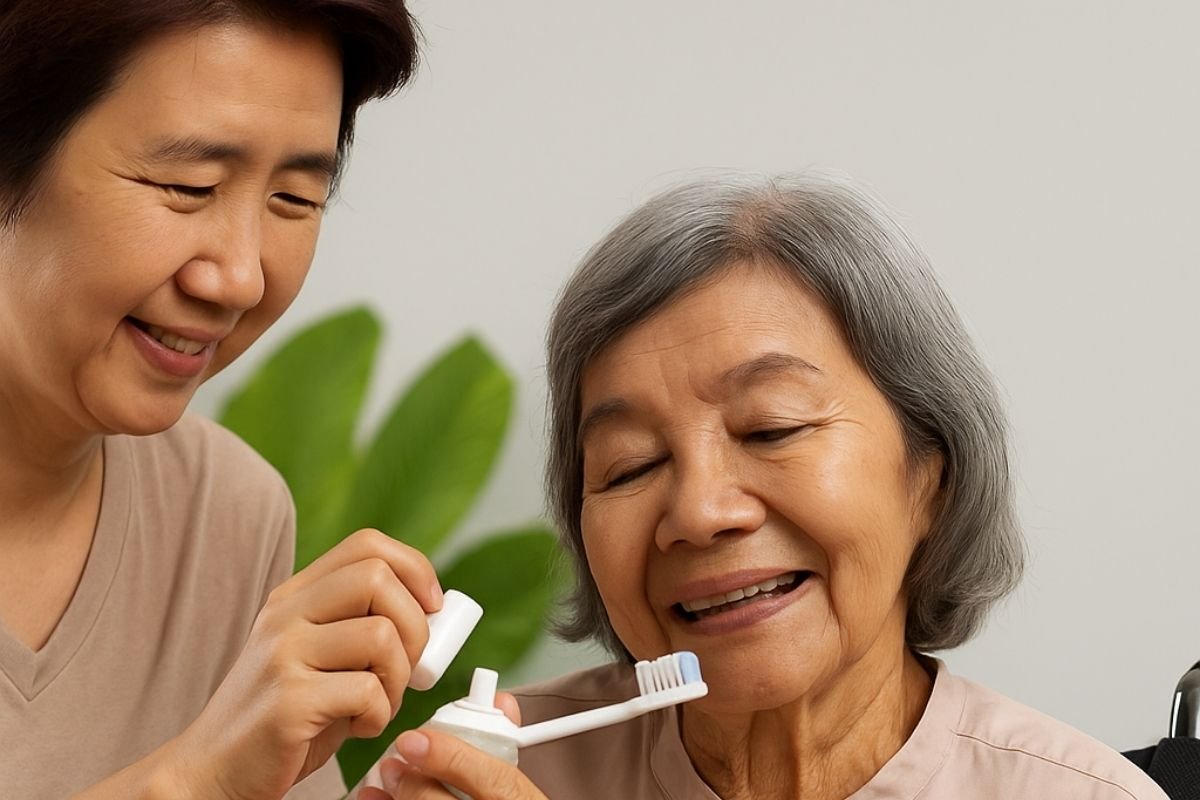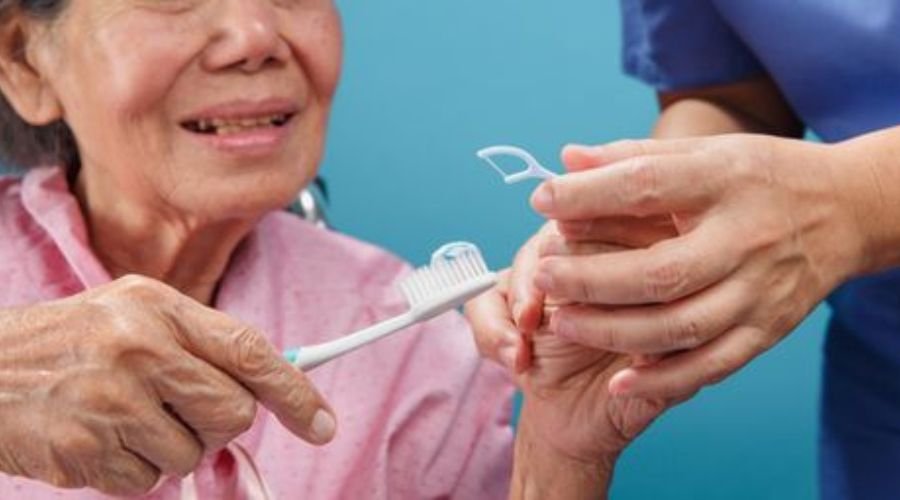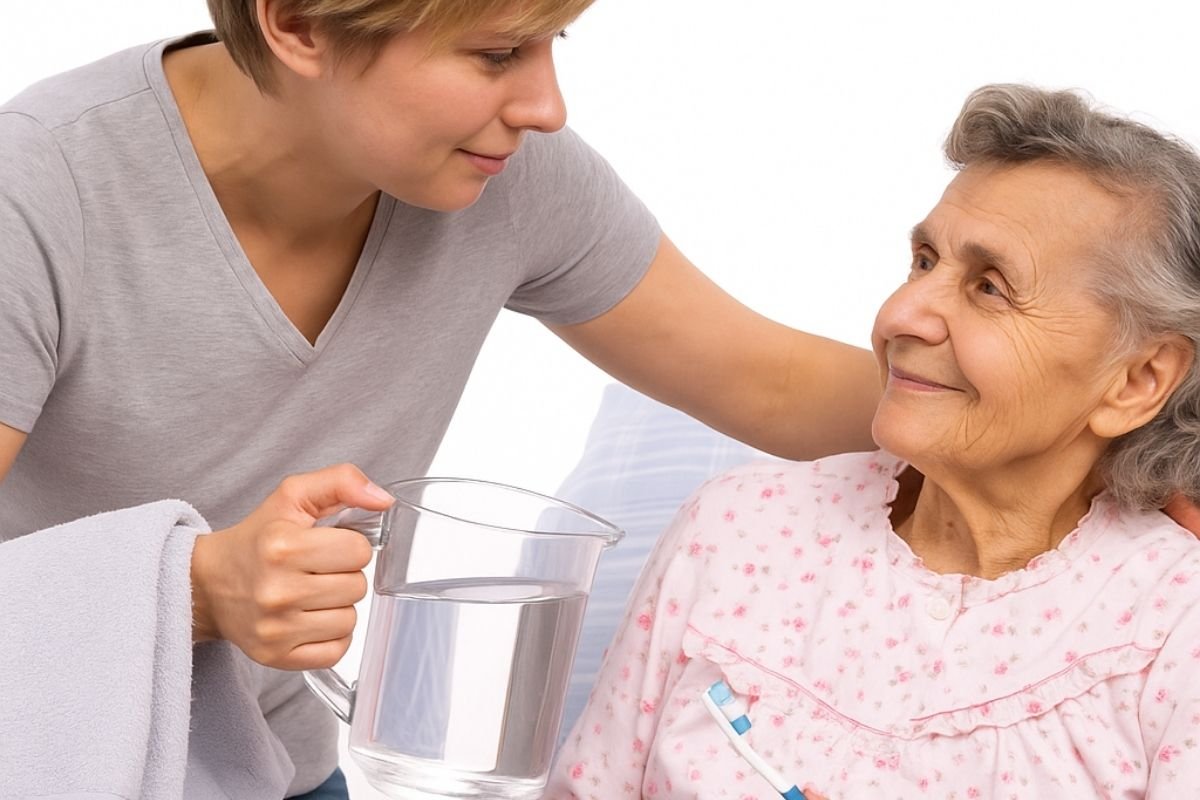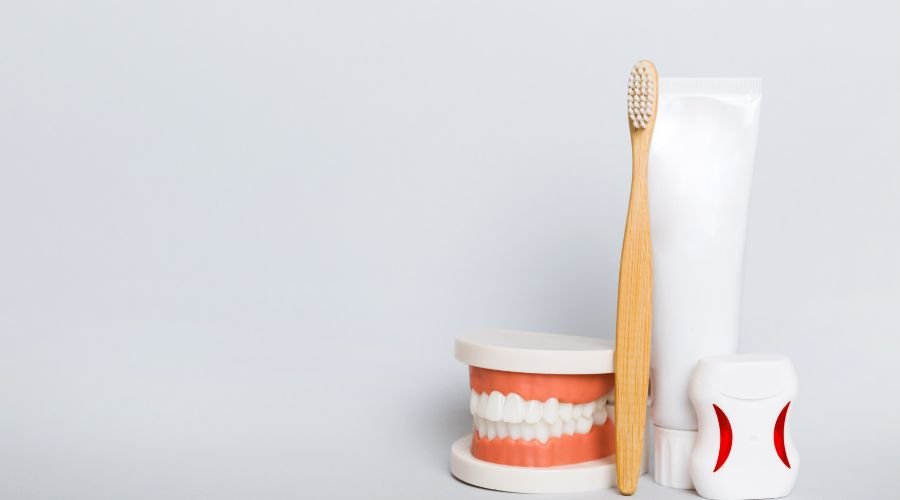Importance of Oral Hygiene
Oral hygiene is a crucial component of overall health and well-being, especially for individuals who may require caregiver assistance. Proper oral care prevents health complications, improves quality of life, and allows for early detection of potential issues.
Health Benefits
- Prevents common oral problems such as tooth decay, gum disease, and bad breath.
- Reduces the risk of systemic infections like pneumonia or heart disease by limiting the spread of oral bacteria into the bloodstream.
- Supports better management of chronic conditions such as diabetes, which can be exacerbated by poor oral health.
Comfort and Quality of Life
- Ensures clients can eat, speak, and smile comfortably, enhancing their daily interactions and self-esteem.
- Regular oral care prevents discomfort caused by dental pain or infections, contributing to better sleep and overall well-being.
Monitoring Health
- Provides an opportunity to detect early signs of oral issues such as sores, bleeding gums, loose teeth, or ill-fitting dentures.
- Early detection facilitates timely medical or dental intervention, preventing complications that could impact general health.

Role of Caregivers in Oral Hygiene
Caregivers play a vital role in maintaining oral hygiene for individuals who may struggle with self-care due to age, disability, or illness. By assisting with daily routines like brushing and flossing, monitoring for abnormalities, and encouraging regular dental check-ups, caregivers help safeguard their clients’ health. Additionally, educating themselves about proper techniques and tools ensures that they provide effective care tailored to each individual’s needs.
In summary, prioritizing oral hygiene not only prevents health complications but also enhances comfort and dignity. Caregivers’ consistent efforts in this area contribute significantly to their clients’ overall quality of life.
Preparing for Oral Hygiene Assistance
Proper preparation is essential to ensure that oral hygiene assistance is effective, comfortable, and safe for the client. By assessing their needs, gathering the right supplies, preparing the environment, and maintaining open communication, caregivers can provide high-quality oral care.
1. Assess the Client’s Needs
- Evaluate the level of assistance required: full assistance for those unable to perform oral care themselves, partial support for clients needing guidance, or supervision for those who can manage most tasks independently.
- Review the care plan for specific oral health concerns such as gum sensitivity, dry mouth, or the use of dentures.
- Take note of any medical conditions (e.g., diabetes or stroke) that may affect their oral health or ability to participate in care.
2. Gather Supplies
- Use a soft-bristled toothbrush or an electric toothbrush for gentle cleaning.
- Have fluoride toothpaste available to strengthen teeth and prevent cavities.
- Include dental floss or interdental brushes to clean between teeth.
- If recommended by a healthcare provider, prepare mouthwash to rinse and freshen the mouth.
- For clients with dentures, gather denture cleaning supplies such as a denture brush, cleaning solution, and a denture cup.
- Use disposable gloves for hygiene-sensitive tasks and a towel or bib to protect clothing from spills.
3. Prepare the Environment
- Ensure the area is well-lit to allow for clear visibility during oral care.
- Arrange a comfortable seating position for the client, ensuring they are sitting upright in a chair or bed to prevent choking or discomfort.
- Place all necessary supplies within easy reach to streamline the process.
4. Communicate with the Client
- Explain each step of the process in advance to reduce anxiety and build trust. For example: “I’m going to help you brush your teeth now.”
- Ask about their preferences, such as toothpaste flavor or specific routines they are accustomed to.
- Check if they are experiencing any pain or discomfort and adjust your approach accordingly.
By preparing thoughtfully and involving the client in decision-making, caregivers can ensure a positive experience while maintaining their clients’ oral health and dignity.
Assisting with Brushing Teeth
Proper tooth brushing is essential for maintaining oral hygiene and preventing dental issues. Caregivers play a vital role in ensuring this process is thorough, safe, and comfortable for the client.

1. Positioning the Client
- Ensure the client is seated upright in a stable chair or supported in bed to prevent choking.
- Place a towel or bib over their chest to protect clothing from water or toothpaste drips.
- If necessary, position yourself at eye level with the client to maintain control and visibility during brushing.
2. Preparing the Toothbrush
- Apply a pea-sized amount of fluoride toothpaste to the toothbrush.
- Slightly wet the bristles if preferred by the client for added comfort.
- Use a toothbrush with soft bristles or an electric toothbrush for gentle yet effective cleaning.
3. Brushing Technique
- Hold the toothbrush at a 45-degree angle to the gums to effectively clean along the gumline.
- Use gentle circular motions to brush all surfaces of each tooth: front, back, and chewing surfaces.
- Brush for at least two minutes, ensuring thorough coverage of all teeth.
- Focus on areas prone to plaque buildup, such as molars and along the gumline, without applying excessive pressure that may irritate sensitive gums.
4. Rinsing and Spitting
- Offer a cup of water for rinsing if the client can spit independently.
- If spitting is difficult, use a suction device or gently wipe away excess toothpaste with a damp washcloth or gauze pad.
- Ensure the client’s mouth is free of toothpaste residue after brushing.
5. Cleaning the Tongue
- Use the toothbrush or a tongue scraper to gently clean the tongue from back to front. This helps remove bacteria that cause bad breath and promotes overall oral health.
- Be cautious not to trigger discomfort or gagging while cleaning.
By following these steps, caregivers can ensure effective tooth brushing while prioritizing the client’s safety and comfort. This routine not only prevents dental issues but also enhances overall well-being and confidence.
Assisting with Denture Care
Proper denture care is essential for maintaining oral health and ensuring the client’s comfort. Caregivers must handle dentures with care and ensure both the dentures and the client’s mouth are clean and healthy.
1. Removing Dentures
- Wash hands thoroughly and wear disposable gloves to maintain hygiene.
- Gently remove the dentures:
- For upper dentures, rock them slightly while pulling downward.
- For lower dentures, rock them slightly while pulling upward.
- Place the dentures in a denture cup filled with water or a recommended cleaning solution to prevent them from drying out or warping.
2. Cleaning Dentures
- Use a denture brush and a non-abrasive denture cleaner to gently scrub all surfaces, including grooves that fit against the gums, where bacteria can accumulate.
- Rinse the dentures thoroughly under lukewarm water to remove any cleaning solution residue, ensuring they are safe for reinsertion.
- Avoid using hot water, as it can damage or warp the dentures.
3. Cleaning the Mouth
- Before reinserting the dentures, clean the client’s mouth using a soft-bristled toothbrush or a damp washcloth.
- Gently clean the gums, tongue, roof of the mouth, and any remaining natural teeth to remove debris and bacteria.
- Apply light pressure to stimulate circulation in gum tissue, promoting oral health and reducing soreness.
4. Reinserting Dentures
- Rinse the dentures with clean water before reinserting them into the client’s mouth.
- Ensure they fit securely and comfortably, adjusting their position gently if needed.
- Ask the client if they feel any discomfort or looseness and address concerns promptly.
By following these steps, caregivers can help maintain proper denture hygiene, prevent oral infections, and ensure that clients feel comfortable wearing their dentures. Regular care also extends the life of the dentures while supporting overall oral health.

Assisting with Flossing
Flossing is a vital part of oral hygiene, as it removes plaque and food particles from between teeth and below the gumline where a toothbrush cannot reach. Caregivers play a key role in ensuring this task is performed effectively and safely.
1. Using Dental Floss
- Prepare the Floss: Cut about 18 inches of dental floss and wrap the ends around your middle fingers, leaving a few inches of floss taut between them for control.
- Gently Slide Between Teeth: Guide the floss carefully between each tooth using a back-and-forth sawing motion to avoid snapping it against the gums, which could cause irritation or injury.
- Form a “C” Shape: Curve the floss into a “C” shape around each tooth and gently slide it up and down along the side of the tooth and just below the gumline.
- Use Clean Sections: Move to a clean section of floss for each tooth to prevent spreading bacteria or debris.
2. Alternative Options
If traditional flossing is difficult due to limited dexterity (for either the caregiver or client) or tight spaces between teeth, consider these alternatives:
- Floss Picks: These are pre-threaded tools that are easier to hold and maneuver, especially for clients with limited mobility.
- Interdental Brushes: Small, bristle-tipped brushes designed to clean between teeth. They are ideal for clients with larger gaps or braces.
- Water Flossers: Devices that use a stream of water to clean between teeth and along the gumline. These are particularly helpful for clients with sensitive gums or difficulty tolerating traditional flossing.
By tailoring the method of flossing to the client’s needs and preferences, caregivers can ensure thorough cleaning while minimizing discomfort. Regular flossing not only promotes oral health but also prevents issues such as gum disease and bad breath, contributing to better overall well-being.
Assisting with Mouthwash Use
Using mouthwash as part of an oral hygiene routine can help reduce bacteria, freshen breath, and promote overall oral health. Caregivers can assist clients in using mouthwash effectively and safely, particularly when it is prescribed by a healthcare provider.
1. Offer Mouthwash After Brushing and Flossing
- Mouthwash is most effective when used after brushing and flossing to rinse away any remaining debris and bacteria.
- Ensure the mouthwash is prescribed or recommended by a healthcare provider, especially if the client has specific oral health needs (e.g., antibacterial or fluoride mouthwash).
2. Assisting with Mouthwash Use
- Pour the Correct Amount: Measure the appropriate amount of mouthwash (usually indicated on the bottle, often about 20 mL) into a cup.
- Assist with Holding the Cup: If the client has limited dexterity or strength, help them hold the cup steady while they take a sip of the mouthwash.
- Guide Them Through Rinsing: Encourage the client to swish the mouthwash around their mouth for about 30 seconds, ensuring it reaches all areas, including between teeth and along the gumline.
- Spitting Out: Provide a basin or direct them to a sink to spit out the mouthwash. If spitting is difficult for the client, use a suction device to remove excess liquid gently.
3. Additional Considerations
- Ensure the client does not swallow the mouthwash, as it may contain ingredients that are harmful if ingested.
- For clients with dry mouth or sensitivity, consider alcohol-free mouthwashes to avoid irritation.
- If using therapeutic mouthwashes (e.g., for gum disease or cavity prevention), follow specific instructions provided by the healthcare provider.
By assisting with proper use of mouthwash, caregivers can help clients maintain a clean and healthy mouth while addressing specific oral health concerns. This step adds an extra layer of protection to their daily oral care routine.
Special Considerations
When assisting clients with oral hygiene, caregivers must adapt their approach to accommodate specific needs, ensuring the process is both effective and comfortable. Tailoring care to the client’s physical or cognitive limitations and any painful conditions is essential for maintaining their oral health and dignity.
1. For Clients with Limited Mobility
- Use Adaptive Tools: Incorporate electric toothbrushes with larger handles or angled brushes to make brushing easier and more efficient for clients with limited dexterity or range of motion.
- Provide Bedside Care: If the client cannot sit in a chair, perform oral care while they are seated comfortably in bed. Ensure they are propped upright with pillows to prevent choking or discomfort.
- Support Their Stability: Assist with holding tools or positioning their head gently to access all areas of the mouth.
2. For Clients with Cognitive Impairments (e.g., Dementia)
- Simplify Instructions: Use clear, simple language and demonstrate each step visually if needed. For example, mimic brushing your own teeth to help them understand.
- Establish Routine Familiarity: Maintain consistency by performing oral care at the same time each day, such as after meals or before bedtime, to build familiarity and reduce resistance.
- Be Patient and Gentle: Approach the task calmly and avoid rushing, as clients with dementia may become anxious or uncooperative if they feel overwhelmed.
3. For Clients with Painful Conditions (e.g., Mouth Sores)
- Use Ultra-Soft Tools: Opt for ultra-soft toothbrushes that minimize irritation and discomfort while cleaning effectively.
- Avoid Abrasive Products: Choose non-abrasive toothpaste designed for sensitive mouths to prevent aggravating sores or inflamed gums.
- Offer Lukewarm Water Rinses: Replace alcohol-based mouthwash with lukewarm saltwater rinses or other gentle alternatives recommended by a healthcare provider to soothe pain and promote healing.
By addressing these special considerations, caregivers can provide personalized oral hygiene care that prioritizes safety, comfort, and effectiveness. This thoughtful approach helps clients maintain their oral health while fostering trust and cooperation during care routines.

Monitoring Oral Health
Monitoring a client’s oral health during daily care routines is crucial for identifying potential issues early and ensuring timely intervention. Caregivers play a vital role in observing, documenting, and addressing oral health concerns.
1. Observe for Signs of Issues During Care
- Look for Common Problems:
- Redness, swelling, or bleeding gums, which may indicate gingivitis or gum disease.
- Mouth sores or ulcers that could be caused by irritation, infection, or underlying health conditions.
- Loose teeth or dentures that no longer fit properly.
- Persistent bad breath (halitosis) or signs of infection such as pus around teeth or gums.
- Document and Report:
- Record any abnormalities in the client’s care notes and report them immediately to your supervisor or healthcare provider as per agency protocols.
- Early reporting ensures prompt medical or dental attention, preventing complications.
2. Encourage Regular Dental Checkups
- Remind Clients About Routine Visits:
- If applicable, encourage clients to attend regular dental checkups to maintain oral health and address any emerging issues.
- Assist with scheduling appointments and arranging transportation if needed.
- Advocate Preventive Care:
- Emphasize the importance of professional cleanings and evaluations, especially for clients with chronic conditions like diabetes or those who wear dentures.
3. Be Proactive with Daily Care
- Use daily oral hygiene routines as an opportunity to monitor changes in the client’s mouth over time.
- Address minor concerns promptly by adjusting care methods (e.g., switching to gentler tools) while escalating more serious issues to healthcare professionals.
By staying vigilant and proactive, caregivers can help maintain their clients’ oral health, prevent discomfort, and contribute to their overall well-being. Regular monitoring also reinforces the importance of oral care as part of a comprehensive health plan.

